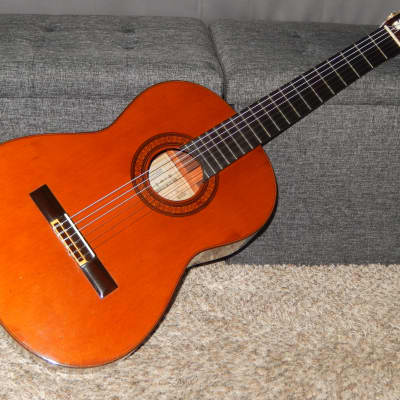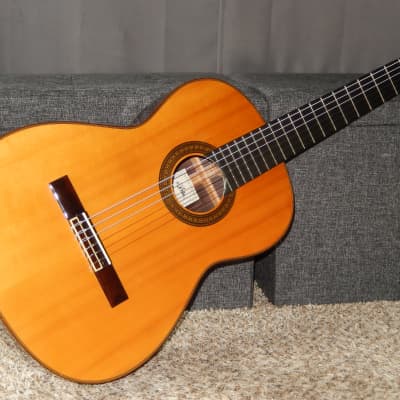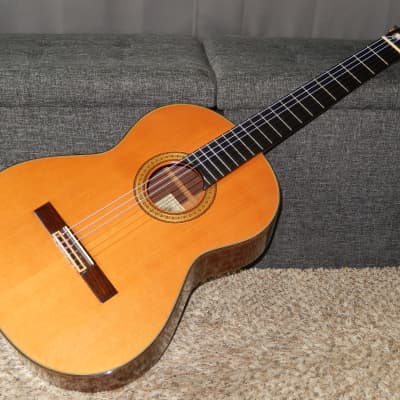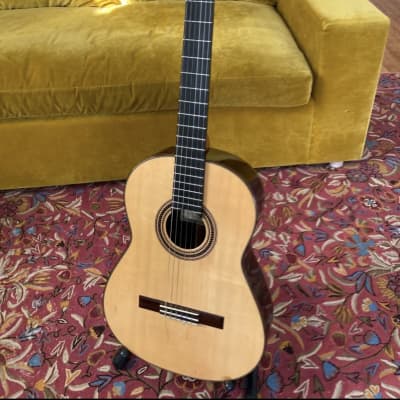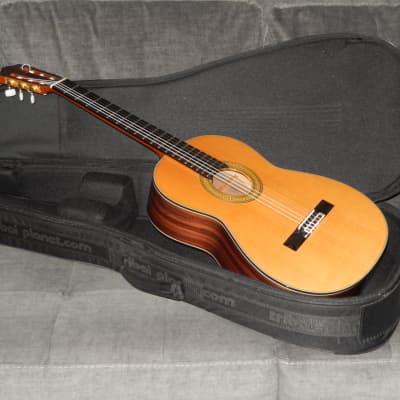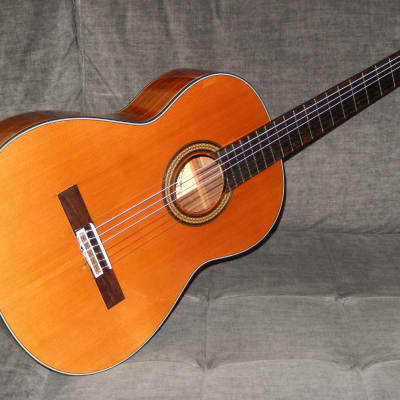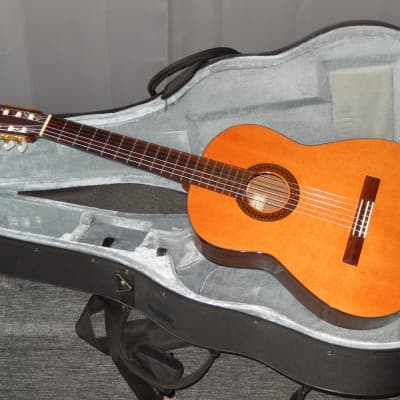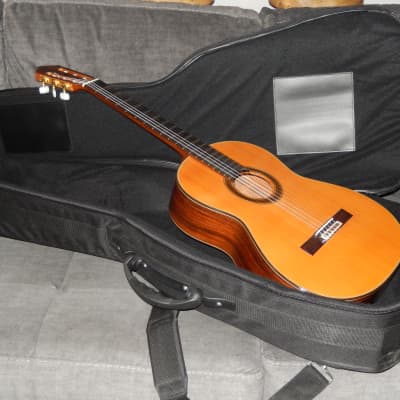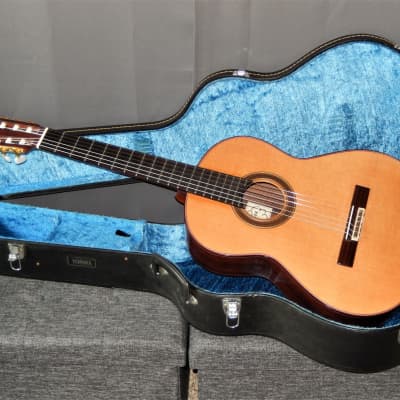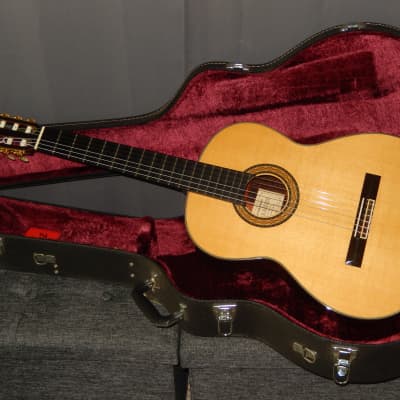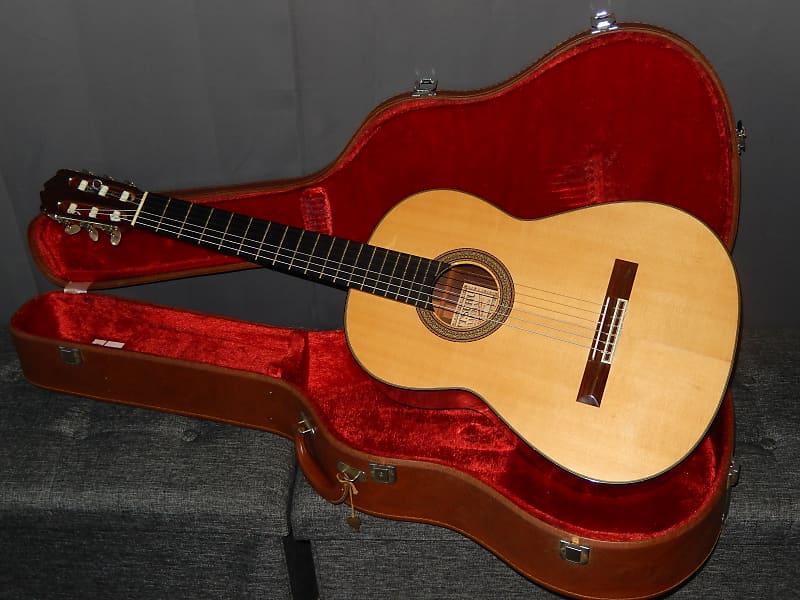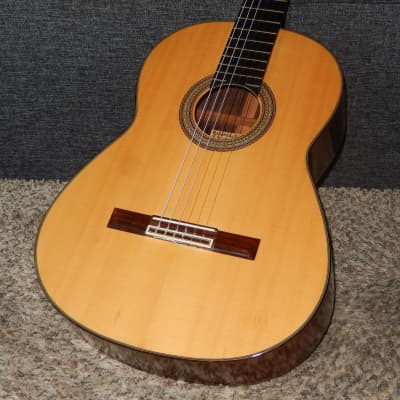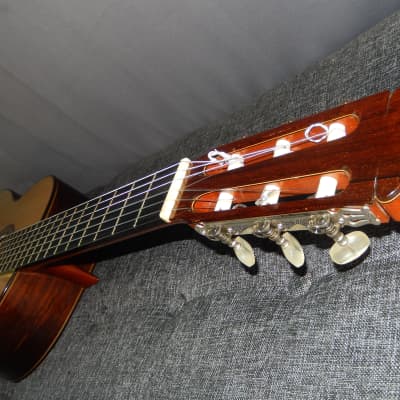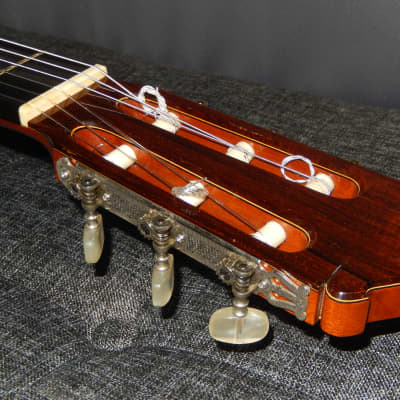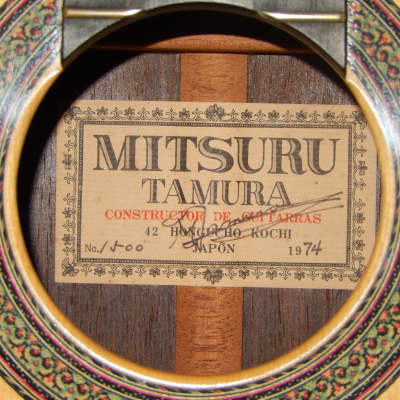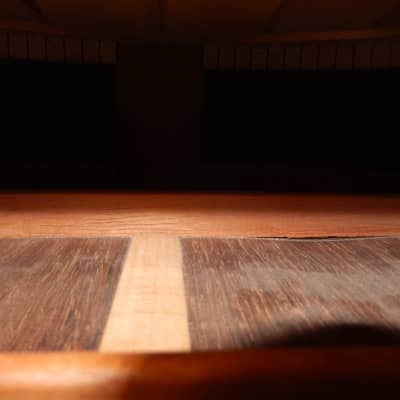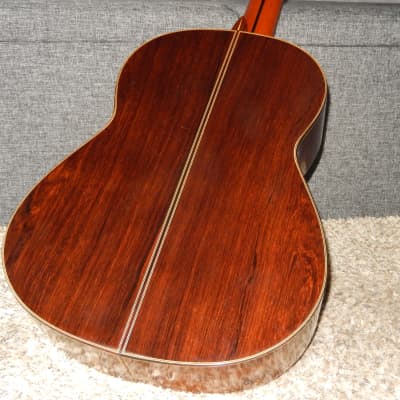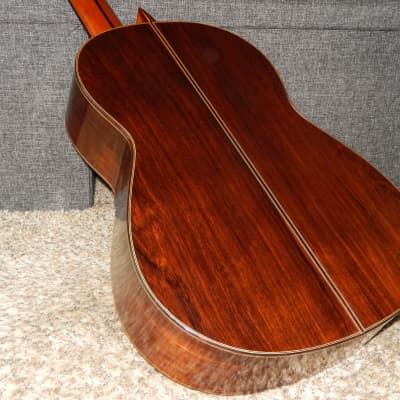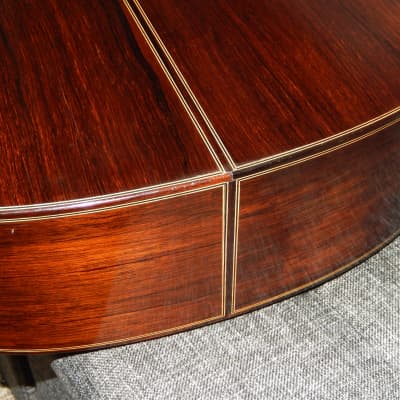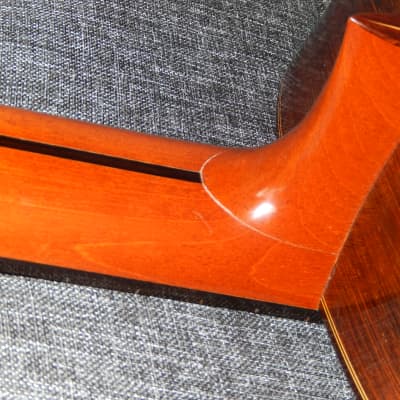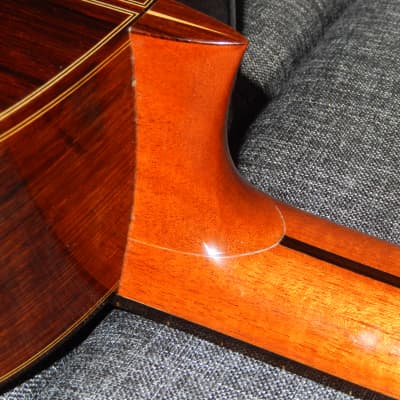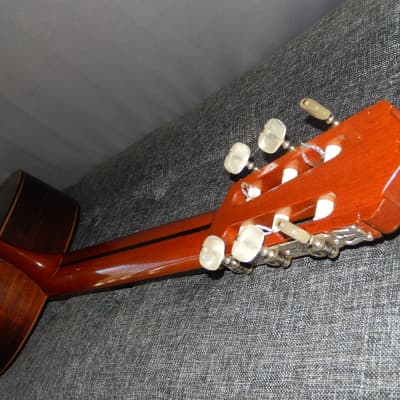MADE IN 1974 MITSURU TAMURA MODEL 1500
This guitar was made in 1974 by Mitsuru Tamura, a brother of better known in the West, Hiroshi Tamura. Both brothers will forever belong to Japanese Elite of Luthiers. You can read their story below this posting
This guitar was priced 150 000 yen in 1974. During that year 99% of Japanese classical guitars sold for 150 000 yen were made with solid Brazilian Rosewood b/s. The only exception was Yamahas GC15M and GC15S. In 1974 the very top models were priced 300 000 yen. However only Japanese top elite luthiers could propose such prices. Besides Masaru Kohno, Sakazo Nakade and Yamaha, this group included Tamura brothers.
As of today, similar grade classical guitars built by Japanese luthiers who are using the same grade 50+ years old woods with shellac finish, would cost you minimum $10000USD. If made by Elite luthier, the price can easily reach $15000USD (Yamaha GC70).
This guitar is very responsive and offers immense volume. It produces truly Spanish sound, with deep almost metallic basses, sweet trebles, all well balanced, with exceptional note clarity and separation, and impressive sustain.
Before you can enjoy its gorgeous sound, this guitar must be taken care of by a luthier. Because it has soft tension strings installed, you can recognize its full potential. Yet you will also hear rattles coming from inside its body.
One obvious reason for that is partial separation between one halve of back plate and one of supporting braces (see picture). This section of the back plate slightly bulged. Besides this one flaw I have not found any other internal damage. Yet it is possible that an experienced luthier may find something else.
For that reason, I have described this this instrument as “non-functioning”.
Other “damages” are visible on the outside.
At the very bottom of the back, there are small cracks in the finish and hair-like gaps between binding, back and side plates.
Also, obviously there was a separation between the neck and its foot. Both parts have been glued back together at some point in time. This must have been very minor separation between both parts. Otherwise, there would be other damages visible in that area.
The neck itself seems to be straight. However, the neck/body angle leads to relatively high (Ramirez style) action even though the saddle is lowered as far as it was possible. Very good condition of fingerboard and frets suggest that this guitar hasn’t been played a lot.
Besides all problems described above the body of this guitar is relatively free from showy dents or scratches.
Specifications:
Top: High Grade Solid Spruce Top/shellac
Back and Sides: Solid Brazilian Rosewood/shellac
Neck: Mahogany with Ebony insert
Fingerboard: Ebony
Nut and Saddle: Bone
Nut Width: 52 mm
Scale: 662 mm
Current action: 4.5mm E6 and 4.00mm E1
It will be shipped in original used case, that survived in very good condition.
Tamura Brothers story:
Just like many other famous Japanese luthiers of that era, Hiroshi and Mitsuru Tamura have learned their craft during their stay in Spain in late 1950s/early 1960s. After their return from Spain Tamura brothers were making superb quality flamenco guitars that easily challenged guitars made by the most famous Spanish luthiers. Their flamenco guitars have earned them international recognition and were played by many professional players. Although these are very hard to find, their oldest flamenco guitars were made in 1962. Strangely enough, their oldest classical guitars available on Japanese second hand market were made in 1967.
It is quite possible that, during 1960s, both brothers shared the same workshop located in Kochi, Japan. Although both brothers were equally skilled, it was Hiroshi who has gathered more international and domestic rewards. As the matter of fact, Hiroshi’s rewards outnumbered those collected by Masaru Kohno.
In 1972 Hiroshi was financially rewarded by Japanese Ministry of Technology. Soon after, he moved to another shop, but not far from his brother’s, hired several associates and started to make his P and C models in greater numbers, successfully exporting many them outside Japan. Only the very top models Hiroshi was making by himself.
Mitsuru Tamura has continued to work as individual luthier, and with just couple of apprentices, was making about 15-20 guitars a month. As the result Mitsuru’s guitars are harder to find on Japanese second hand market and their often reach higher prices than guitars made by Hiroshi.
Sometime in 1976, after his “factory” started to produce great financial losses, Hiroshi had to declare bankruptcy and moved back to smaller workshop, making fewer number of guitar with just couple of helpers.
Tamura brothers passed away sometime in mid1980s. Just like in case of their superb flamenco guitars, their classical guitars are equally regarded in Japan.
The key to understand value of vintage Japanese guitars is to acknowledge galloping price inflation (devaluation of Japanese yen) during 1960s & 1970s. This inflation slowed down in 1980s.
During 1960s and most of 1970s model numbers of Japanese guitars were strictly interconnected with their prices in Japanese yen. By early 1980s and during following decades model numbers were no longer strictly associated with their prices. Some Japanese guitar makers introduced model names instead of model numbers. Others were still using model numbers with addition of letters and/or other symbols.
It is then important to understand that two Yamaha GC10 guitars made 10 years apart are two instruments of totally different class. The same applies to any other Japanese maker/brand.
The logical way to estimate the true class of any given Japanese made instrument is to compare its price with the average annual salary of wage workers in Japanese private sectors. This salary was: 450 600 yen in 1965 - 825 900 yen in 1970 - 1 868 300 yen in 1975 - 2 689 000 yen in 1980 - 3 163 000 yen in 1985 - 3 761 000 yen in 1990 - 4 107 000 yen in 1995 - 4 082 000 yen in 2000.
Any guitar priced 100 000 yen in 1970 (labelled as No10 or No100) would be priced 200 000 yen in 1975 (relabeled to No20, No200 or 2000), 300 000 yen in 1977 (labelled as No3, No30 or 3000) and 500 000 yen by 1985 (labelled as No50 or 5000).
Starting in 1977 Masaru Kohno introduced his new models No40 priced 400 000 yen and No50 priced 500 000 yen. By early 1980s Kohno started using model names instead of numbers and was steadily raising their prices without changing model labeling. His very top model 50 became model “Special”, and a decade later it became model “Maestro”. Naturally, all other Japanese guitar makers were doing similar pricing (labelling) upgrades.
Knowing all of that, you can bet on that Masaru Kohno No50 made in 1982 is practically the same grade instrument as Kohno No20 made in 1972, or Kohno no 30 made in 1975.
In early 1970s the lowest Ryoji Matsuoka (all plywood) model was 10, followed by (solid top) models 15, 20, 25, 30, 40, 50, 60, 80 and (all solid woods) models 100 and 150. Models 50, 60 and 80 were made with non-solid figured Brazilian Rosewood (double) back and sides and top model 150 was the only one made with solid figured Brazilian Rosewood b/s.
In 1980 the lowest Matsuoka model was (all plywood) 20, followed by (solid top) models 30,40,50, 60 and all solid woods models 80,100,150 and 200. By 1990 the lowest Matsuoka model was M40 and the highest was M300. By 2010 the lowest Matsuoka model was M50 and the top model was M270.
You can bet that Ryoji Matsuoka model 50 from 1980 is of the same grade as model M100 from 2000, model 100 from 1980 is of the same grade as model M150 from 2000, model 150 from 1980 is of the same grade as M200 from 2000 and model 200 from 1980 is of the same grade as model M300 from 2000.
It is important to mention that if modern era luthiers are using 40+ years old woods to make an “all solid” wood classical guitar, its price is minimum $8000.
All vintage guitars made with Brazilian Rosewood are especially precious, including those made straight grain varieties and those with non-solid b/s.
Because response and tonal properties of Spruce soundboards are improving over time, long seasoned Spruces are far more precious than long seasoned Cedars.
It is not very difficult to find out what are current prices of such guitars made by world’s leading luthiers.

